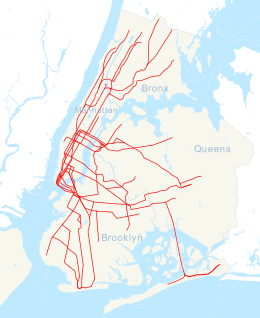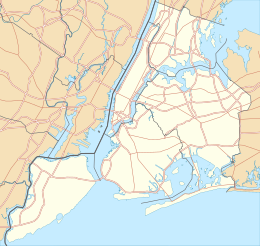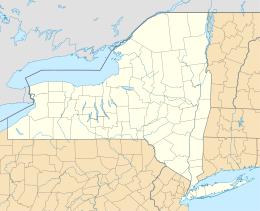
The Worth Street station was a local station on the IRT Lexington Avenue Line of the New York City Subway. It is located at Lafayette Street and Worth Street, in Civic Center, Manhattan.

The Spring Street station is a local station on the IRT Lexington Avenue Line of the New York City Subway. Located at the intersection of Lafayette Street and Spring Street in SoHo and Little Italy, Manhattan, it is served by 6 trains at all times, <6> trains during weekdays in the peak direction, and 4 trains during late night hours.
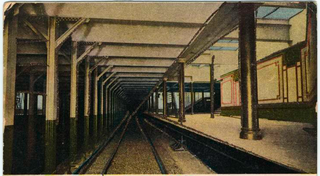
The 18th Street station was a local station on the IRT Lexington Avenue Line of the New York City Subway. It was located at the intersection of Park Avenue South and 18th Street in Gramercy, Manhattan.
The IRT Broadway–Seventh Avenue Line is a New York City Subway line. It is one of several lines that serves the A Division, stretching from South Ferry in Lower Manhattan north to Van Cortlandt Park–242nd Street in Riverdale, Bronx. The Brooklyn Branch, known as the Wall and William Streets Branch during construction, from the main line at Chambers Street southeast through the Clark Street Tunnel to Borough Hall in Downtown Brooklyn, is also part of the Broadway–Seventh Avenue Line. The IRT Broadway–Seventh Avenue Line is the only line to have elevated stations in Manhattan, with two short stretches of elevated track at 125th Street and between Dyckman and 225th Streets.
The Lenox Avenue Line is a line of the New York City Subway, part of the A Division, mostly built as part of the first subway line. Located in Manhattan, New York City, it consists of six stations between Central Park North–110th Street and Harlem–148th Street, all of which are situated within the neighborhood of Harlem in Upper Manhattan.

The 116th Street–Columbia University station is a local station on the IRT Broadway–Seventh Avenue Line of the New York City Subway. It is located at the intersection of Broadway and 116th Street in the Morningside Heights neighborhood of Manhattan, just outside the west gate to the main campus of Columbia University and the southeast corner of the Barnard College campus. The station is served by the 1 train at all times.
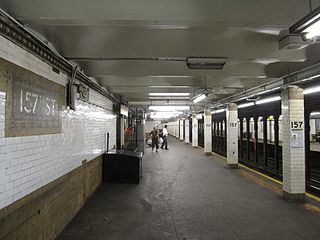
The 157th Street station is a local station on the IRT Broadway–Seventh Avenue Line of the New York City Subway. Located at the intersection of Broadway and 157th Street in Washington Heights neighborhood of Manhattan, it is served by the 1 train at all times.

The 145th Street station is a local station on the IRT Broadway–Seventh Avenue Line of the New York City Subway. Located at the intersection of Broadway and 145th Street in Hamilton Heights neighborhood of Manhattan, it is served by the 1 trains at all times.

The 137th Street–City College station is a local station on the IRT Broadway–Seventh Avenue Line of the New York City Subway. Located at the intersection of 137th Street and Broadway in Hamilton Heights neighborhood of Manhattan, it is served by the 1 train at all times. The station serves the nearby City College of New York and Riverbank State Park.

The 66th Street–Lincoln Center station is a local station on the IRT Broadway–Seventh Avenue Line of the New York City Subway. Located at the intersection of 66th Street and Broadway in the Lincoln Square neighborhood of Manhattan, it is served by the 1 train at all times and by the 2 train during late nights.

The 72nd Street station is an express station on the IRT Broadway–Seventh Avenue Line of the New York City Subway, located at the intersection of Broadway, 72nd Street, and Amsterdam Avenue in the Upper West Side neighborhood of Manhattan. It is served by the 1, 2, and 3 trains at all times.

The 96th Street station is an express station on the IRT Broadway–Seventh Avenue Line of the New York City Subway. Located at the intersection of 96th Street and Broadway in the Upper West Side neighborhood of Manhattan, it is served by the 1, 2, and 3 trains at all times.

The 50th Street station is a local station on the IRT Broadway–Seventh Avenue Line of the New York City Subway. Located at the intersection of 50th Street and Broadway in the Theater District of Manhattan, it is served by the 1 train at all times and by the 2 train during late nights.

The Central Park North–110th Street station is a station on the IRT Lenox Avenue Line of the New York City Subway, located at the intersection of 110th Street and Lenox Avenue at the southern edge of Harlem, Manhattan. It is served by the 2 and 3 trains at all times.

The 59th Street–Columbus Circle station is a New York City Subway station complex shared by the IRT Broadway–Seventh Avenue Line and the IND Eighth Avenue Line. It is located at Columbus Circle in Manhattan, where 59th Street, Broadway and Eighth Avenue intersect, and serves Central Park, the Upper West Side, Hell's Kitchen, and Midtown Manhattan. The station is served by the 1, A, and D trains at all times; the C train at all times except late nights; the B train during weekdays until 11:00 p.m.; and the 2 train during late nights.

The Cathedral Parkway–110th Street station is a local station on the IRT Broadway–Seventh Avenue Line of the New York City Subway. Located at the intersection of Cathedral Parkway and Broadway in the Morningside Heights neighborhood of Manhattan, it is served by the 1 train at all times.

The 103rd Street station is a local station on the IRT Broadway–Seventh Avenue Line of the New York City Subway. Located at the intersection of 103rd Street and Broadway in the Upper West Side neighborhood of Manhattan, within Manhattan Valley, it is served by the 1 train at all times.

The 86th Street station is a local station on the IRT Broadway–Seventh Avenue Line of the New York City Subway. Located at the intersection of West 86th Street and Broadway in the Upper West Side neighborhood of Manhattan, it is served by the 1 train at all times and the 2 train during late nights.

The 79th Street station is a local station on the IRT Broadway–Seventh Avenue Line of the New York City Subway. Located at the intersection of 79th Street and Broadway in the Upper West Side neighborhood of Manhattan, it is served by the 1 train at all times and the 2 train during late nights.

The Broadway–Lafayette Street/Bleecker Street station is a New York City Subway station complex in the NoHo neighborhood of Manhattan on the IRT Lexington Avenue Line and the IND Sixth Avenue Line. It is served by the 6, D, and F trains at all times; the B and M trains on weekdays during the day; the <6> and <F> trains during rush hours in the peak direction; and the 4 train during late nights.

